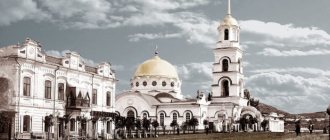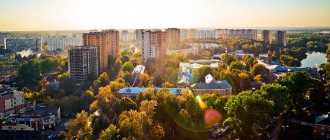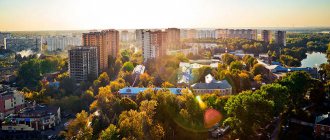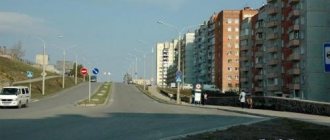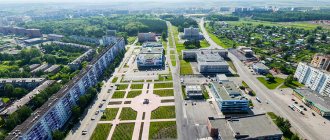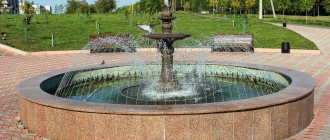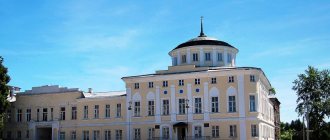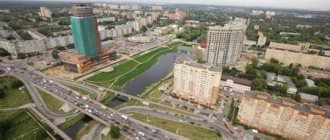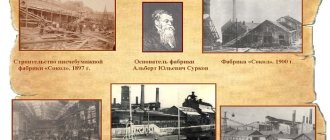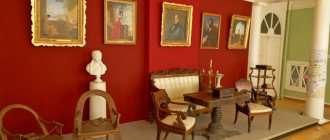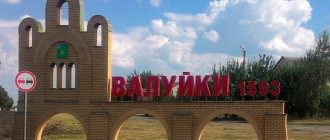Troitsk is a small picturesque city located in the southeastern part of the Chelyabinsk region. It is distinguished by a unique architectural heritage that has perfectly preserved its original appearance. The city is famous for its rich cultural traditions, high intellectual potential and abundance of sunny days, the number of which is even greater than in the famous Sochi.
We selected the main attractions of Troitsk (Chelyabinsk region) for our tourist, found beautiful places where the whole family should definitely go or take a walk with a girl. We marked the location of objects on the map to create an independent route, and selected very tasty restaurants in the city where you can spend an inexpensive evening in a cozy atmosphere. We recommend that you trust our experience and beginners; we have highlighted as a separate item what to see in Troitsk in one day; a fascinating excursion will be of interest to those who do not know where to start.
Water tower
The structure was built in 1927 on a deserted site. The building was designed by architect Sanzharevsky in a post-modern style and is visible from any part of the city. The tower belongs to a private person and requires restoration work.
- address: st. Gagarina, 22.
Holy Trinity Cathedral
A beautiful old Orthodox building with a high bell tower and spire, which is located on the embankment of the Uy River. The first stone for the construction of the cathedral was laid in 1754 on the site of the Trinity Fortress, which had existed since 1743. The founder of the city, the fortress and the cathedral is the same person - Ivan Neplyuev. The construction project was developed by the famous Italian architect Trezzini; he also designed the Cathedral of the Peter and Paul Fortress in St. Petersburg. In 1842, the temple suffered a severe fire. It was soon restored, but in 1974 it burned again. The cathedral received its final historical appearance in 2000, and now it has its original appearance.
- address: st. Krasnogvardeyskaya, 26.
Holy Kazan Convent
Holy Kazan Convent
When visiting the sights of Troitsk, Chelyabinsk region, check out this monastery. The monastery is located on a hill in the western part of the city outskirts. It officially began its existence in 1851, and by the end of the 19th century it was considered the richest in the Orenburg diocese. A hospital, an orphanage, a pharmacy, a sewing and icon-painting workshop were opened at the Holy Kazan Monastery. But after the revolution it was closed. The monastery was opened only in 1996, and now it is one of the centers of the spiritual life of the city.
- address: st. Gagarina, 10/1;
- Opening hours: morning worship - 6.30; Liturgy - 7.30; evening service - 17.00;
- official website: https://sv-kasan.cerkov.ru/.
Alexander Nevskaya Church
The temple building is located next to the bus station, belongs to architectural objects of regional significance and is often seen in photos of Trinity. The church was consecrated in 1889, and later two chapels were built in the classical style. In 1961, by decision of the regional council, it was closed and converted into a theater, and in 1963 it was given over to the local history museum. The temple was returned to believers only in 1991. Nowadays there is a Sunday school at the church, where children are taught church literacy, singing and culture.
- address: st. Western, 2.
Church of Demetrius of Thessalonica
The temple, consecrated in 1873, belongs to the Holy Trinity Cathedral. It is made in a classical style, decorated with baroque elements. The church has the shape of a ship, with left and right aisles. In 1930 the temple was closed, and in 1947 it was again handed over to believers. Today the church runs a Sunday school for children and adults.
- address: st. Gagarina, 7a;
- Opening hours: liturgy - 8.30; evening service - 17.00;
- official website: https://dmitxram.cerkov.ru/.
Chapel of the Icon of the Mother of God “Three-Handed”
The structure was erected with donations from the Ozeretskovskaya monastery and consecrated in 1911. Attractions in Troitsk with photos and descriptions also contain an image of the chapel, which is an original building, decorated with elements of neo-Russian style. The building has patterned walls, and its roof is a complex profile structure with a small dome. In 1930, the chapel was closed, and in 2013 it was again transferred to the monastery.
- address: st. Volodarsky, 24.
Ghataullah-Mullah Mosque
The mosque received this name in honor of its first imam. According to new data, it was built in 1897, and ceased to operate in 1937. For many years, various organizations were located in its premises. In 2002, restoration and restoration work began with funds from the city and regional administration, as well as caring citizens. Only in 2009, the first prayer was performed here on Bayram. The mosque is one of the cultural heritage sites of Russia and can be seen among photos of Troitsk attractions.
- address: st. Lenina, 117.
Former Bashkirov hotel, now “Central”
The Art Nouveau building, built in 1909, is located in the heart of the city. Its owner was the merchant Bashkirov, who, having arrived at the next fair in 1908, overheard the complaints of visiting merchants about the lack of a first-class hotel in Troitsk. He argued with them, lying that there was such a hotel in the city, and in order not to be among the losers, he worked hard to build it, sparing no expense. So in one year Troitsk received a fashionable hotel. In 2011, after restoration, the Central Hotel opened in the building.
- address: st. Klimova, 9;
- Opening hours: 24 hours a day;
- https://hotel-c.ru/.
Museum of Local Lore
If you are still thinking about what to see in Troitsk, visit the local history museum. Paintings, rare books and sculptures, antiques, weapons, coins, numerous photographs and other unique items have been carefully preserved in the museum since its founding in 1925. Today they tell their guests a lot of interesting things about past times.
- address: st. Nagornaya, 9;
- Opening hours: Tue-Fri 12.00-18.00; Sat 12.00-16.00; Sun, Mon — closed;
- official website: https://troick-museum.ru/.
Shopping arcade of the Yaushev brothers
A large three-story building, built at the end of the 19th century on the initiative of the Yaushev entrepreneurs. The brothers owned businesses in Tashkent, Kazan and other cities, but decided to move to Troitsk. Seeing them as competitors, local authorities allocated them a place in the swamp for construction. However, with the help of the architect Fedorov, they solved this problem, and in 1913 the construction of a beautiful building in the Baroque, Renaissance and Neoclassical styles was completed. Now the shopping arcade is included in the list of attractions of the city of Troitsk, Chelyabinsk region. Its first floor is occupied by an electromechanical plant, while the top two are empty.
- address: st. Malyshev, 34.
Shopping arcades
A commercial building built by local merchants in 1866 in the historical part of the city. Its construction was headed by the elder Pupyshev. The façade of the building stretches for an entire block of Oktyabrskaya Street. After the revolution, warehouses were located on its territory, and in the 70-90s of the last century there was a landfill there. Since 1993, the Trade Rows have been included in the list of architectural landmarks of national importance and their restoration has begun. Today, part of the rows is occupied by the Trinity branch of Chelyabinsk University, and part is reserved for shops.
- address: st. Klimova, 5a.
Crosses-amulets
What else is Troitsk famous for? For the first time in Russia, amulets crosses were installed on each side of the city, which marked the beginning of the revival of the historical tradition. The crosses are white, have an ancient Byzantine shape, are made of concrete and weigh 8.5 tons. They symbolize blessing, spirituality and rebirth.
City House of Culture
Entertainment in Troitsk includes numerous cultural events that are constantly offered by various groups of the House of Culture. Citizens and guests of the city enjoy spending their free time here. The building has existed since 1889. Initially, it was planned to hold meetings of the nobility there.
- address: st. 30 years of the Komsomol, 36.
Monument to Neplyuev in Troitsk (Chelyabinsk region)
Installed in the central city square, where locals like to spend their free time. Neplyuev I.I. was the founder of Orenburg and the Orenburg province, which, along with other territories, included the modern Chelyabinsk region. Ivan Ivanovich was a talented diplomat, privy councilor and statesman. He consistently implemented the reforms of Peter I.
- address: st. Gagarin.
Monument to the Holy Trinity
The architectural structure was installed in 2001 in memory of Neplyuev. The monument is made in the form of a stele located on a rectangular granite pedestal. In the center of the stele there is a bas-relief depicting the Holy Trinity, and on its reverse side, on a bronze tablet, the date of creation of the city and the origin of its name are indicated.
- Address: Dmitrievskaya Square.
Memorial "Oath"
When visiting the monuments of the city of Troitsk, take a look at the Memory Square, where this memorial is installed. It reminds of the 7,481 defenders of the city who died in that terrible war, and the local population affectionately calls it “Alyosha.”
- address: st. Gagarin.
About the history of the city of Troitsk
The founder of Troitsk was the governor of the Orenburg region, Ivan Neplyuev. On June 19, 1743, by his decision, a fortress was built on the left bank of the Uy River, and on the right - an exchange yard (operating until 1915) and a border customs house. The name was thought up immediately: work on the construction of the fortress began on the eve of the Orthodox holiday of Trinity.
An important trade caravan route from Asia to Europe then passed through the future city of Troitsk, so this place for the fortress and customs was not chosen by chance.
The idea worked: Troitsk quickly became not just a fortress bordering the Steppe, but a large and successful barter point between Russian and Asian merchants. Since May 1750, there was a fair here, which was noisy every year throughout the warm season: from May to October in the exchange yard. Its official turnover grew rapidly, reaching a huge amount of 2.5 million rubles per season. The exchange yard, which was initially made of wood, became completely stone by 1822.
During the Pugachev uprising, in May 1774, fierce battles broke out in Troitsk. But the rebels managed to capture the fortress for only one day.
In 1784, by decree of Catherine II, Troitsk was given the status of a city. Thanks to successful and lively trade, it even outwardly looked like a prosperous, successfully developing city.
By the end of the 19th century, this city had 14 thousand inhabitants, hundreds of retail shops and dozens of enterprises of different nature and scale: tanning, flour milling, lard making, brewing, soap making, candle making, glue making and others. There were eight Orthodox churches, four mosques and one synagogue in Troitsk.
An old photo of the city of Troitsk
This was the heyday of the city. Troitsk could afford to become not only a trade center, but also an important educational and cultural center of the region. Schools, colleges, madrasahs, and a library began operating there. In 1891, Troitsk was visited by the heir to the throne, the future Tsar Nicholas II. He stayed in the house of the merchant Zarubin on the street. Klimova, 16, which has survived to this day.
The Civil War did not bypass Troitsk: the city changed hands more than once - sometimes red, sometimes white.
And during the Great Patriotic War, several industrial enterprises from the west of the USSR (machine tool plant, electromechanical plant) were transported to Troitsk. The Troitskaya State District Power Plant, the construction of which began in 1954, became an important industrial facility.
Currently, the city operates an electromechanical plant and a mineral wool production plant, Troitskaya State District Power Plant; food and light industry enterprises, locomotive depot.
The population of Troitsk reached 91 thousand people in 1986. But then it began to gradually decline.
The best fabulist of all times, Ivan Andreevich Krylov, was born in Troitsk and spent the very first years of his life. Documents about his birth have not been preserved, but it is known that the father of the future brilliant writer, Lieutenant Andrei Prokhorovich Krylov, lived with his wife in Troitsk from 1765 to 1769.
Sun, air and water!
It is impossible not to mention one more component of the city’s investment attractiveness. Statistical data for many decades show: in terms of the average annual number of sunny days, Troitsk surpasses even the all-Russian health resort of Sochi. Add to this the clean air that residents of large industrial cities miss so much. Yes, located in the steppe zone, Troitsk cannot boast of either dense forests or gray mountain peaks, and the Uy and Uvelka rivers flowing through the city, of course, cannot compete with the Volga or Yenisei. And yet, the nature of Troitsk can also surprise you - with lush steppe herbs, a clear blue sky, the song of a lark... History goes hand in hand with nature - ancient houses, caressing the eye with the whimsical architecture of the 18th-19th centuries, the very spirit of the city in which merchants once met from dozens of countries. Therefore, the tourism industry in Troitsk certainly has a future. Wandering through the quiet streets, admiring the antiquity, sunbathing under the hot sun, plunging into a leisurely river, taking a healing mud bath (there are also mud springs in the Troitsky district) is not a paradise for a tourist?
Water tower
The first iconic landmark of the city, which is found right at the entrance to its central part, is the water tower, built in the style of early postmodernism.
Water tower
It seems that this octagonal structure in the Gothic style was erected somewhere in the Middle Ages. However, it was built in Soviet times - in 1927, according to the design of the architect V. Sanzharevsky. The tower is deservedly recognized as an architectural monument.
Address: st. Gagarin.
Temple of Dmitry of Thessalonica, monument to the founder of the city and memorial steles
On the same street there is the Church of Demetrius of Thessaloniki. It was erected in 1873, and in 1889 a stone bell tower was added to the church. The temple is designed in a classical style, with Baroque elements. During the Soviet era, the church was closed for several years, but in 1947 it was returned to believers.
Monument to the founder of the city
In the park in front of the temple there is a monument to the founder of the city, Ivan Ivanovich Neplyuev. It was installed there in 2001. In addition, the church also contains memorial steles: to the first builders of Trinity, the Trinity Fair and the Christian holiday of Trinity.
Address: st. Gagarina, 7a.
Economics and transport
Troitsk is a modern settlement with developed infrastructure. Multi-storey residential buildings predominate here. The city is very green and surrounded by forests. There are no harmful enterprises. Combined with intensive housing construction, this leads to population growth. Schools, a lyceum, 2 gymnasiums, kindergartens, medical institutions, a sports school, and shops were built here; The sphere of consumer services is developed.
But the transport situation is still quite unfavorable. This is due to congestion on the Kaluga Highway, which connects Troitsk with Moscow. Construction of the metro line was supposed to begin in 2022.
Kazan-Bogoroditsky convent with the Church of the Transfiguration
The Kazan-Bogoroditsky convent was founded in 1851, but was closed during the years of atheism (in the 1920s). One of the monastery churches - Kazan - was dismantled into bricks. The Church of the Transfiguration of the Lord (built in 1870) has been preserved. He is active.
Of the pre-revolutionary buildings of the monastery, the building of the Nikolaev school for girls, built in 1896, as well as the building of the hotel for pilgrims, have also survived to this day.
Kazan-Bogoroditsky convent with the Church of the Transfiguration
The Holy Kazan Convent was revived in the 1990s, through the efforts of Mother Ksenia Kadomtseva. The monastery is open for visits and excursions every day.
Address: st. Gagarina, 1/10.
What to see for a tourist in Troitsk: TOP-5
There are several cities with the name Troitsk on the map of our vast country, one is now part of the Moscow region. Its Ural namesake lies at the confluence of the Uy and Uvelka rivers, 121 km from Chelyabinsk, not far from the Russian-Kazakh border. The city is famous for its architectural monuments of different eras, religious and cultural sites of two faiths and ethnic groups. At the beginning, interesting places are highlighted that will allow you to get a first impression of Troitsk, its history and features.
Dmitrievskaya Square
- Address: Lenin street.
The center of attraction for tourists, the center of city life and one of the calling cards of Troitsk has become the square of an unusual angular shape, located in the western part of the city. Previously, it was called Tabunna, and today it is called Dmitrievskaya, in honor of St. Demetrius of Thessaloniki.
Many significant city attractions are located on or near the square. In 2000-2001, the appearance of the square was transformed, monuments were erected, and a park was laid out nearby.
Monument to I.I. Neplyuev
- Address: Gagarin street.
The history of the city of Troitsk officially began on May 22, 1743 according to the old calendar. On this day, a fortress was founded, named in honor of the Holy Trinity. Its origin is associated with the name of the military and political figure of the Elizabethan era, Admiral Ivan Neplyuev, known for his services in the organization of the South Ural lands.
One of the dominant features of the current appearance of Dmitrievskaya Square and the adjacent park is the monument to this man. The founder of the city is depicted in full growth, he stands in a thoughtful pose, leaning on a saber and directing his gaze to the center of the settlement. This monument is the creation of a group of authors; the monument was cast in Moscow and installed in 2001.
Holy Kazan (Kazan-Bogoroditsky) convent
- Address: st. Gagarina, 1/10.
Arriving in the city of Troitsk, you should definitely visit the active women's Orthodox monastery, the history of which began in 1851. Initially it was a small community at the cemetery church; by 1865 it was officially approved by order of the Holy Synod as a monastery.
Over more than half a century of its history, the monastery has grown, and in 1896 it acquired a parish school, opened to commemorate the coronation of the new monarch, Nicholas II. At the turn of the 19th-20th centuries, it was considered the largest and richest monastery among the monasteries belonging to the Orenburg diocese.
Before the revolution, about 70 nuns lived here. During Soviet times it was closed, the temple buildings were partially destroyed, rebuilt, and used for other purposes. In 1993, by decision of the Russian Orthodox Church, the monastery was returned to religious life.
Holy Trinity Cathedral
- Address: Krasnogvardeyskaya st., 1A.
The main religious attraction of Trinity, in addition to the monastery, is the city’s cathedral of the same name, majestically rising along the banks of the Uy River. The settlement also owes its appearance to Neplyuev. Almost a decade after the founding of the fortress, namely in 1754, a temple was founded on its territory.
The name of the architect adds historical and cultural significance to the religious building. It was the famous foreign specialist Pietro Antonio Trezzini, known for his buildings in St. Petersburg. The temple in the Ural Troitsk, according to sources, is the creation of Pietro Antonio.
Over almost three centuries of its history, the cathedral building suffered two fires, was restored and rebuilt. In the 1840s it was significantly expanded. After the revolution, the temple was closed and returned to believers in 1997.
In the 2000s, restoration work began with the goal of recreating the historical appearance; both the external decoration and the interior were restored. Wall paintings of the 19th century based on surviving fragments were reproduced by S. Kolomytsev and V. Yartseva.
Museum of Local Lore
- Address: st. named after V.I. Lenina, 70.
Fans of historical and cultural tourism often begin their acquaintance with the city from the Museum of Local Lore. It has existed in Troitsk for almost a century; it was established in 1925. Here you can find materials on the history and culture of different eras.
The archaeological part, which is of great interest to visitors, will allow you to come into contact with the antiquities discovered on the territory of the Trinity Fortress. The permanent exhibition tells about the founding of the city, the main stages of its development, the life of the townspeople and merchants, and the peculiarities of local everyday culture. Of the events of recent history, special attention is paid to the Great Patriotic War; a separate exhibition is dedicated to it.
The museum's collection includes a numismatic collection, rare books, and a rich art section. Traditionally for museums of this profile, its halls combine historical, ethnographic and natural science topics; one of the departments is dedicated to the natural features of the region, its flora and fauna.
Holy Trinity Cathedral
This church is the first stone building in the city of Troitsk. It was founded in 1754 and completed in 1761. The Trinity Fortress was located on this site, which gave rise to the city.
Holy Trinity Cathedral
During Soviet times, the temple was closed (finally in 1940), and its building in different years was used as a warehouse for raw hides, a construction office, a dormitory, a laundry, a boiler room, and a gym. In 1997, the church was returned to the believers. The building of the Holy Trinity Cathedral has the status of a cultural heritage site of federal significance.
Address: st. Krasnogvardeyskaya, 1.
Population of Troitsk (Moscow)
There is little data on the population of this city. Obviously, this is due to its small number. After all, the number of residents of Troitsk is very small. In 2022, only 60,924 people lived in this science city. However, the population is increasing rapidly. This has been especially pronounced in recent years. Thus, in 2009, the number of city residents was only 36,762 people. In the 90s and zero years, the population grew at the slowest rate.
The population density of the city of Troitsk is 2900 people/km².
Temple of Alexander Nevsky
In the second half of the 19th century, on Trinity Zarechnaya Sloboda, people built a church in honor of St. Prince Alexander Nevsky. Construction dates back to 1884-1889 from foundation to consecration.
Temple of Alexander Nevsky
Like most other churches, this church was closed by the Soviet authorities. But not destroyed. The date of its revival coincides with the date of the fall of the USSR - 1991.
Address: Shosseynaya street.
Employment
The employment situation in Troitsk can be characterized in one phrase: high wages, but little work. As of the end of September 2022, the Employment Center offers only 3 vacancies (not counting the standard vacancies for all cities of the Russian Federation for work on a rotational basis). The city needs 2 department heads and a driver. The salary of a department head is from 38 thousand rubles, and that of a driver is from 60 to 63 thousand rubles. The work schedule in all three cases is variable. Probably the majority of Troitsk residents get jobs in Moscow, which can be reached along the Kaluga Highway.
Church of Elijah the Prophet
This Orthodox church with its characteristic rounded dome is the only example of neo-Byzantine style architecture in the city of Troitsk. The Church of Elijah the Prophet was built in 1895 and operated at the local prison. The sponsor of the construction, the merchant Kormiltsev, wanted the prisoners to have the opportunity to fully perform all religious rituals and celebrate Orthodox holidays.
Church of Elijah the Prophet
Both the prison church and the prison itself were closed with the establishment of Soviet power. At the same time, the prison was dismantled for building materials, but the Church of Elijah the Prophet was left. In 1998, its restoration began, and in the early 2000s the temple became operational again.
Address: st. Denisova, 3b.
Orthodox churches and mosques of Troitsk
Orthodox culture is reflected in the very name of Trinity. The religious life of the city, which became a meeting place of the Slavic and Turkic worlds, united Christianity and Islam. There are noteworthy temples of both faiths here.
Transfiguration Cathedral
- Address: st. Gagarina, 1/10.
The main temple of the Holy Kazan Convent, the largest building of the monastery complex and one of the main attractions of the city is the majestic five-domed white-stone Transfiguration Cathedral. It was erected from 1863 to 1870. The initiator and sponsor of the construction was the city merchant P. Tatarinov.
The walls of the temple remember the last Russian monarch; while still Tsarevich Nikolai Alexandrovich Romanov came here on a visit and bestowed the Icon of St. Nicholas the Wonderworker.
The valuable Shrine has been preserved to this day under the jurisdiction of the temple. During the years of religious oblivion, the cathedral building was used for various needs; it managed to be a quartering place for troops, a military school and a sports hall. After the revival of the monastery, the temple became operational again
Church of Demetrius of Thessalonica
- Address: st. Gagarina, 7A.
Behind Neplyuev, near the square now named after Dmitry of Thessaloniki, stands a temple dedicated to this saint. The “ship-type” structure belongs to the classical architectural style with Baroque elements in the external decor.
It was erected in 1873 as a cemetery church assigned to the Holy Trinity Cathedral. From 1930 to 1947 the temple did not function, after which it was returned to believers and is still in use today. There is a Sunday school at the church.
Alexander Nevsky Church
- Address: Shosseynaya street.
In the second half of the 19th century, settlers from the Samara, Kazan and Tambov Provinces lived in the so-called “zarechnaya settlement”. On the initiative of the residents, a church was erected here in honor of St. Alexander Nevsky using public funds.
Construction dates back to 1884-1889. from the moment of laying to consecration. In terms of its architectural appearance, it is somewhat similar to the Demetrius Church, differing in two later added chapels in the classic style.
Merchants from neighboring regions took part financially in the arrangement of the temple, iconostasis and the surrounding area. Since 1893, a parochial school was established at the church. In the 1960s the closed church housed a temple and a museum. It became operational again in 1991.
Church of Elijah the Prophet
- Address: st. Denisova, 3B.
The brick religious building with a characteristic rounded dome is the only example of neo-Byzantine style architecture in the city. The Church of Elijah the Prophet was built in 1895 as a prison church and was assigned to the Holy Trinity Cathedral.
The merchant Kormiltsev financed its construction. With the advent of Soviet power, the prison was liquidated, the church was closed in 1920, and 10 years later they wanted to dismantle it into bricks for the purpose of using building material.
Fortunately, this important cultural and architectural monument for the city has not disappeared. In the post-war period, the building served as an archive room, and later there was a ski base here. In 1998, restoration began and the temple became operational again.
Mosque named after Zainulla-Hazrat Rasulev
- Address: Oktyabrskaya street, 122.
An architectural monument of regional significance, the Islamic temple appeared in the city in 1863 thanks to the merchant G.Yu. Yaushev, who donated funds for its construction. In those years, the number of Muslims in the city exceeded 4 thousand people. Initially called the Third Cathedral Mosque, the first imams were representatives of the Rakhmankulov family.
It is known that Friday services in this temple were conducted by the famous Muslim preacher Zainulla Rasulev. Today the mosque is named after him. This decision was made in 2008, when the Islamic temple, after being forgotten during the Soviet era and several decades of restoration work, was restored and returned to believers.
Ghataullah Mullah Mosque
- Address: st. named after V.I. Lenina, 117.
The second city mosque, built in 1894-1985, is also considered an object of cultural heritage of the peoples of the Russian Federation. Its construction was also sponsored by one of the representatives of the Yaushev merchant family, Abdulvali Akhmetzhanovich. Initially it was the sixth cathedral mosque, now named after its first imam. Inactive from the 1920s until the early 1990s. In the first decade of the 21st century, restoration took place.
Chapel in honor of the Icon of the Mother of God “Three-Handed”
- Address: st. Volodarsky, 24.
The latest of the monastery buildings, dated 1911. The small elegant chapel attracts with its unusual appearance and decor; the architectural appearance contains features of the neo-Russian style. It was built with donations. It served as a prayer room and a church monastery shop. It was closing. It was again transferred to the monastery in 2013.
Shopping arcades and a complex of ancient buildings of the local branch of ChelSU
On Klimov Street the buildings of the ancient Trading Rows have been preserved. They were built in the 19th century, and in Soviet times were used as warehouses. Nowadays, part of the building was transferred to the Trinity branch of Chelyabinsk State University (CSU). The shopping arcades have the status of a cultural heritage site of federal significance.
Complex of ancient buildings of the local branch of ChelSU
Nearby, in old buildings, also built in the 19th century, the Trinity Branch of ChelSU is located (Oktyabrskaya St., 79). In the summer, beautiful fountains operate next to them.
Shopping arcade of the Yaushev brothers
Representatives of the Yaushev merchant family owned trading houses in many cities of the country. At the turn of the 19th and 20th centuries, their business empire began to operate in Troitsk.
Despite the fact that they got the site for the construction of the passage on a wetland, by 1911 a magnificent building designed by Arkady Fedorov had risen on it. Its architecture organically combines three styles: neoclassicism, renaissance and baroque. At the time of its appearance, this building was very progressive and technologically advanced in terms of technical solutions and equipment. For its construction, a special drainage system was used. And the foundation was mounted on larch piles and a lead cushion.
Shopping arcade of the Yaushev brothers
The passage was initially full of all the technical innovations of that time: telephone communications, elevators, electric lighting. In the regional center of Chelyabinsk there is a “sibling” of the Trinity Passage, which is occupied by the Chelyabinsk Museum of Art.
Address: st. named after the Malyshev Brothers, 32.
We build for people
As you know, active construction is one of the most important signs of a successfully and stably developing economy. Since they are building, it means they are confident in the future. One of the leading construction enterprises in Troitsk is Elektromontazh-Troitsk LLC: it has such construction projects in the city as the Osobnyak building materials and electrical products store, equipped no worse than Chelyabinsk construction showrooms. So citizens can buy everything they need for repairs comfortably.
What is the situation with affordable housing in Troitsk? It must be said that the pace of construction in Troitsk is slowly but steadily growing. Houses in the GRES village are put into operation every year. Basically, the city grows along the Chelyabinsk - Troitsk highway. There are plans to build several new microdistricts, the first two ten-story buildings in the city have been built, and there are plans to build another “high-rise.” The site is now being cleared for construction.
“Developing new territories is not an easy task,” admits Mikhail Vinogradov, Deputy Head of Troitsk for Construction and Infrastructure. “And yet we have several promising projects ready for the construction of new, comfortable and relatively inexpensive housing. However, we must not forget about the social sphere. Thus, at the beginning of this year, a modern municipal clinic was put into operation, and preparations are underway for the construction of a cultural and entertainment center.
Memory Square. Memorial "Oath" and Alley of Heroes
In the 1970s, a military memorial dedicated to all participants in the Great Patriotic War was erected in the central city square. This memorial is called “The Oath”. Its central figure is a statue of a Soviet soldier, bending one knee and swearing to avenge his comrades.
Memory Square. Memorial "Oath" and Alley of Heroes
Next to the “Oath” memorial, also on the territory of the Memory Square, there are seven busts of natives of the city and the surrounding area who fought on the fronts of the Great Patriotic War and were awarded the high title of Heroes of the Soviet Union. This part of the park was called the Alley of Heroes.
Address: corner of Malyshev Brothers and Gagarin streets.
Employment of the population of Troitsk
As of the end of September 2022, the city requires workers for various specialties. Among them there are many technical ones. Salaries vary: from 12,837 rubles to 42,171 rubles. The smallest is for an accountant, electrician, turner and athlete. Such salaries also occur in the field of pedagogy. The highest is for an engineer.
In general, salaries up to 15-20 thousand rubles dominate the list of vacancies. Salaries above 20,000 are rare.
Monument to Ivan Andreevich Krylov
In the city of Troitsk in 2022, a sculptural group was installed dedicated to the famous native of the city - the great Russian fabulist I.A. Krylov and the heroes of his fables.
The statues were made by masters of the Kasli plant, famous for artistic cast iron casting. Kasli sculptor, member of the Union of Artists of Russia Natalya Kulikova worked on the images.
Monument to Ivan Andreevich Krylov
The main figure is the fabulist himself, who sits on a bench and watches the characters in his fable “The Crow and the Fox.” A crow with cheese in its beak sits on the back of a bench, and on the ground in front of it sits a fox with its paws pressed to its chest. In addition, it was decided to depict the characters from the fables “Quartet” and “The Monkey and the Glasses” in the casting.
Location: Klimova street.
Ancient buildings in the Central Square area
Before the revolution, the city's Central Square was called Mikhailovskaya - St. Michael's Cathedral stood on it, demolished in 1967. Now on the Central Square there is a city administration building (Klimova St., 7). In the old days, this building, built in 1873, occupied a fire station.
The complex of historical buildings of the Central Square also includes the Main Post Office building (Lenin St., 69). The post office is located in the former mansion of the merchant Osipov.
Hotel Bashkirova
The most beautiful building in the city of Troitsk is the Bashkirov Hotel (Klimova St., 9). It was built in Art Nouveau style in 1908 by merchant Gavriil Alekseevich Bashkirov, and is intricately decorated with a colonnade, rich stucco moldings and multi-colored stained glass windows. This building, restored in 2011, is an architectural monument of federal significance.
Bashkirov, while at the Nizhny Novgorod fair, made a bet with local merchants who did not believe him that in Troitsk there was a magnificent hotel with a first-class restaurant. Returning home, Bashkirov urgently invested a large sum of money in the construction of a modern hotel.
And when Nizhny Novgorod merchants arrived at the Trinity Fair, they were amazed by the beauty of the brand new hotel, quickly built in the Russian Art Nouveau style.
Across the road, in the former building of the Siberian Bank 1893-1903. buildings, there is the Trinity Museum of Local Lore (Lenin St., 70). Here you can get acquainted with the history of the city in a fascinating way.
Sights of Troitsk
There are more than 70 historical and cultural monuments in Troitsk, 5 of them are of federal significance. No wonder Troitsk is called an open-air museum.
The first iconic landmark of the city that you encounter upon entering it is the water tower . It stands at the beginning of Gagarin Street at the entrance to the central part of the city. It was built already in Soviet times - in 1927. The tower was erected in the style of early postmodernism according to the design of the architect V. Sanzharevsky. It has an openwork octagonal design in the Gothic style. It is an architectural monument.
On the same street there is the Church of Dmitry Solunsky (Gagarin St., 7a). It was built in 1873, and in 1889 a stone bell tower was added. Built in a classical style with baroque elements. During Soviet times it was closed, but already in 1947 it was returned to believers. Researcher V.I. Yurin writes that under the church (in the basement under the ceiling) there is an underground passage-air duct of a rectangular shape. It served to heat the building.
But what is more interesting here is not so much the church as the square in front of it. In the center of the square there is a monument to the founder of the city, Ivan Ivanovich Neplyuev (1693-1773). It appeared in 2001, created according to the design of sculptor Vladimir Zharikov.
Also in the park there are steles dedicated to the First Builders of Trinity, the Trinity Fair and the holiday of the Trinity .
Nearby is the Kazan-Bogoroditsky convent with the Church of the Transfiguration of the Savior from the mid-19th century, and on the other side is the park of culture and recreation named after. Tomina .
Then you can get to the Holy Trinity (Uysky) Cathedral (Krasnogvardeyskaya St., 1). In the past, this is where the Trinity Fortress stood, from which the city began. This church is the first stone building of Trinity. It was founded in 1754 with the participation of Governor General I.I. Neplyueva. Construction was completed in 1761. Subsequently, the church suffered from attacks by the Pugachevites and fires; it was rebuilt several times. In Soviet times, in different years there was a raw leather warehouse, a construction office, a dormitory, a laundry, a boiler room, and a gym located here. Now the church is active. In 2001, on the glass of the icon of St. Nicholas the Wonderworker, believers noticed a print with the image of the saint, which they took for a miracle. This icon can be seen here today. The building has the status of a cultural heritage site of federal significance.
In the park near the Holy Trinity Cathedral, a memorial stone in honor of the founding of the Trinity Fortress. Nearby, in November 2022, representatives of the Armenian diaspora erected a khachkar cross , reminiscent of the Armenian genocide. Interestingly, it is made by hand from tuff mined in the vicinity of the Ararat Valley. There is a bridge across the Uy River nearby.
On the street Klimova, 5a, the buildings of the Trading Rows . They were built in 1866-68 on the central square of the city at the expense of merchants Yaushev, Pupyshev, Osipov, Bakirov, Zarubin and others. They included a façade and two wings on the south side of the main city square. During Soviet times, the premises were used as warehouses. Nowadays, part of the building was transferred to the Trinity branch of Chelyabinsk State University (CSU). The shopping arcades have the status of a cultural heritage site of federal significance.
Nearby, in old buildings of the 19th century, the Trinity branch of ChelSU is located (Oktyabrskaya St., 79). In the past, shops and warehouses were located on the ground floor, and the second floor was rented by the city council. In summer there are fountains nearby.
A monument to the famous lawyer F.N. was erected nearby in 2013. Plevako - a native of Troitsk.
There is also a monument to V.I. Lenin , opened on November 7, 1924. Before the revolution, a bust of Emperor Alexander II stood on this marble pedestal.
In the past, Central Square was called Mikhailovskaya - St. Michael's Cathedral stood on it, demolished in 1967. On the Central Square there is the city administration building (Klimova St., 7). The house, built in 1873, was previously occupied by a fire station.
In 1892-94, the building was rebuilt and transferred to the District Court. Lawyer Fyodor Plevako also spoke here a couple of times. The memorial plaque reminds us of this.
And across the road, in the former building of the Siberian Bank 1893-1903. buildings, houses the Trinity Museum of Local Lore (Lenin St., 70, tel. (35163) 2-12-52). Here you can get acquainted with the history of the city.
Also famous among the museums of Troitsk is the Anatomical Museum, located on the territory of the Ural State Academy of Veterinary Medicine (Gagarina St., 13). It has 2 thousand natural preparations. Here you can see stuffed animals, skeletons of rare animals, archaeological finds, preparations of animal and human organs. It is sometimes called one of the best anatomical museums in the country.
But let's return to Central Square. Across the street from the museum and from the city administration is the building of the Main Post Office (Lenin St., 69). The post office is located in the former mansion of the merchant Osipov, which was later transferred to the customs department. When the Troitsk customs house was abolished in 1868, the city government moved here.
Behind the city administration building is the most beautiful building in Troitsk - the Bashkirov Hotel (Klimova St., 9). The building was built in Art Nouveau style in 1908 by merchant Gavriil Alekseevich Bashkirov. It is decorated with a colonnade, rich stucco and multi-colored stained glass windows. The building was restored in 2011. It is an architectural monument of federal significance.
According to legend, while at the Nizhny Novgorod fair and heavily drunk, Bashkirov made a bet with three local merchants who did not believe him that in Troitsk there was a magnificent stock exchange hotel with a first-class restaurant. In fact, at that time Troitsk had only inns and furnished rooms. But a bet is a bet, and once he gave his word, Bashkirov invested a significant part of his fortune in the construction of a luxury hotel. Just a year later, at the opening of the next Trinity fair, a building in the Russian Art Nouveau style designed by the architect Fedorov appeared before the amazed merchants. According to another legend, at least a kilogram of silver and gold coins was laid under the foundation of the building.
Surprisingly, only the main facade of the building looks beautiful. From the end there is an ordinary brick plane.
On the street Brothers Malyshev, 32 there is another beautiful building - Yaushev Passage . It was built by order of the Yakushev merchants in 1911. In pre-revolutionary Russia, large, expensive stores were called passages. Like the Bashkirov Hotel, this building was built by the architect Fedorov. Since the area here was swampy, larch piles and a lead cushion were used for the foundation. A drainage system was also used. The passage was equipped with telephone communication, an elevator and electric lighting. Alas, this building is not in use and is gradually being destroyed. Nearby there is a memory square with the Oath memorial.
Also in Troitsk, an ordinary-looking wooden house in which L.A. Kulik (Volodarsky St., 26).
To be fair, it is worth noting that not everything in Troitsk is ideal. There are many abandoned, dilapidated beautiful mansions, and garbage is often found on the streets.
In Soviet times, a reservoir , so the Uy and Uvelka rivers within the city are quite wide. The power plant's pipes are visible from afar.
On the right bank of the Uy River there is an interesting natural attraction of the city - Pugachev Cave . It's not big. According to measurements by V.I. Yurina, 19 m long. It is located in a remnant 25 m high, at a height of 8 m above the water. It has two entrances, the vaults are heavily smoked. Researcher V.I. Yurin writes that this is the longest cavity in serpentinite rocks in the Chelyabinsk region. It is pseudokarst, of gravitational-tectonic origin. Since 1969, the cave has been a geological and geomorphological natural monument of the Chelyabinsk region.
According to legend, during the siege of the Trinity Fortress, Emelyan Pugachev’s tent stood here, and from here the head of the rebels watched the capture of the fortress. According to another legend, Pugachev allegedly rested in this cave after being wounded in the arm, received the day before as a result of an unsuccessful assassination attempt. There is also a traditional legend that another Pugachev treasure is hidden here.
The city of Troitsk is located in a steppe area, so the few forests found here are valued. The botanical natural monument Park “Steppe Dawns” is located on the right bank of the Uvelka River on the western outskirts of the city. This park was laid out back in the 1880s with several alleys around the summer cottages of the Trinity merchants Urazaev, Volkov and Nanbaev. Balsam poplar, Scots pine and Siberian larch were planted here. In 1919, a kumiss clinic for pulmonary patients was organized on the basis of the estate, and later a bone-tuberculosis sanatorium was created here. The species composition of the park's plantings was enriched in the post-war years. To this day, plantings of trees over 100 years old have been preserved in several places. Alas, in the 1970s, almost all Scots pine died due to drought.
Even more valuable is the “Golden Sopka” pine forest on the left bank of the Uy River, also declared a natural monument of the Chelyabinsk region. This island pine forest is a relict of the Pleistocene periglacial forest-steppe and is of great importance.
It is worth noting that the city of Troitsk is also attractive due to its abundance of sun. In terms of the average annual number of sunny days (2218 hours/year), it is even ahead of Sochi! It is considered the sunniest city in the Urals and one of the sunniest in Russia.
And one more interesting fact: Chelyabinsk Troitsk is often confused with Moscow. When, preparing for a trip to Troitsk, I booked accommodation there with a local resident, she asked if it was Troitsk that I was calling. He says that Muscovites often call by mistake.
Trinity Museum of Local Lore
This municipal cultural institution is the first museum in the city dedicated to its history and culture.
It was created on August 13, 1925. Over the hundred-year history of its existence, the Trinity Museum of Local Lore has accumulated rich art and archaeological collections, collections of numismatics, household items and documentary sources - in total, over forty thousand items.
Trinity Museum of Local Lore
The exhibition presents interesting sections of archeology, the history of the Trinity Fortress, fair trade, merchant life; rich collection of paintings; books of the 17th-18th centuries. In 2022, the museum's new exhibition hall opened after major renovation and reconstruction.
Since 2022, the Trinity Museum of Local Lore, together with the local historical reconstruction club “Beaver Rush,” annually holds the “Southern Frontier” historical reconstruction festival. It is dedicated to medieval themes.
Address: st. Lenina, 70.
Anatomical Museum
Far beyond the city of Troitsk, the Anatomical Museum is known, which is located on the territory of the Ural State Academy of Veterinary Medicine, on Gagarin Street, 13. It has two thousand natural exhibits.
At its exhibitions you can see stuffed animals and skeletons of rare animals, archaeological finds, and individual dissected organs of animals and humans. Thanks to its rich collection, this institution is rightfully considered one of the best anatomical museums in our country.
Address: st. Gagarina, 13.
Where to eat deliciously in the city?
We recommend that you end the evening after a walk through interesting and beautiful places in good restaurants with delicious cuisine. We have selected some truly atmospheric establishments that are a must-visit in Troitsk with your girlfriend or the whole family.
- Roadside Picnic Restaurant is located at km 41. Kaluga Highway in a quiet forest location, ideal for tourists who like to sit in nature in good conditions with delicious cuisine. In the summer we definitely recommend booking a gazebo; julienne and fish soup are excellent. The average bill for one adult will be 1,600 rubles. Tel.
- Restaurant Zarechye on Zarechnaya 14a. It is also located in a quiet green area, but already within the city and next to the river, you can dance in the evening. We definitely book a gazebo in the summer. The cuisine is Russian and European, the presentation and preparation of dishes is excellent. The average bill is 1700 rubles. Tel.
- Cafe My coffee on the street. Kurochkina 19. One of the delicious and inexpensive cafes in the city for tourists who decide to just sit and order coffee with croissants, which are prepared here at the highest level. It’s not for nothing that the cafe has high ratings according to reviews. Tel: +7.
Park of Culture and Leisure named after. N.D. Tomina
The main park of culture and recreation in Troitsk is named after Nikolai Dmitrievich Tomin, a Red military leader, a hero of the Civil War, who in 1918 commanded the Troitsk detachment of Red Guards.
The park on this territory appeared before the revolution - in 1908. During the Soviet years, it repeatedly strengthened its reputation as the best vacation spot in Troitsk. It is not for nothing that the park is very popular. This is due to its walking distance and well-developed infrastructure for spending time with family and children.
The park has a whole range of attractions, sports and playgrounds. There are two Ferris wheels - a larger one and a smaller one. There is also a small artificial pond, and rental of children's boats for water trips is organized.
Park of Culture and Leisure named after. N.D. Tomina
In winter, this park has a skating rink where the whole family can skate to positive music. They also build slides for skiing, made of snow and ice.
In the park named after Tomin, festive events are regularly held on calendar holidays - New Year, Christmas, Maslenitsa and Victory Day. City Day in Troitsk is celebrated in the summer, together with Russia Day and on the eve of the Trinity Day. These days, it has become a tradition to organize a special program: representatives of different national cultures pitch their tents, offer national dishes and folk songs. Since 2009, a rock festival in memory of Viktor Tsoi has been held every year in the park.
The central entrance to the park is located on Sovetskaya Street.
Address: st. In honor of the 30th anniversary of the Komsomol.
To be fair, it should be noted that not all historical and architectural monuments in Troitsk look decent. The city also has a lot of abandoned, dilapidated buildings, and on the streets you can often find unkemptness and disorder. But there are fewer and fewer shabby, depressing-looking places every year.
Nature of Troitsk and its surroundings
In the city itself and its surroundings, it is easy to find attractions where it will be pleasant to walk, relax and unwind.
Park of Culture and Leisure named after. N.D. Tomina
- Coordinates on the map: 54.084738, 61.551241.
Along with the House of Culture, the Leisure Center is the only organized park in the city center. It was laid out back in 1908, and a summer club operated on its territory. In Soviet times, the city park of culture and recreation was named after the military leader from the civil war N.D. Tomina, which he wears to this day; a monument to this figure has been erected in the park.
On an area of 6.5 there are shady alleys for quiet walks and unity with nature, a small artificial pond on which you can ride by renting a boat and a catamaran, as well as a variety of park entertainment. There are two Ferris wheels - large and small, many other attractions for children and adults, and areas for sports.
River Uy
- GPS coordinates: 54.074739, 61.553249.
One of the two rivers found in Troitsk, the Uy, is the left tributary of the Tobol. It flows through the territory of Bashkiria, Kurgan and Chelyabinsk regions, on the border of Russia with Kazakhstan. Its waters separate the forest-steppe and steppe natural zones. Troitsk and its surroundings are a great place to get acquainted with an interesting body of water.
Pugachevskaya cave
- Coordinates: 54.071406, 61.580108.
Not far from Troitsk, on the banks of the Uy River, there is a geological monument covered in historical legend and thereby attracting even more attention.
The natural object is a mountain with a rocky ledge and a depression in the form of a cave. There is a belief that it was in it that the leader of the peasant uprising Emelyan Pugachev hid a treasure, which is why the cave was nicknamed Pugachevskaya.
Natural monument “Steppe Dawns”
- Coordinates: 54.097491, 61.494495.
On the right bank of the Uvelka River there is a park that is almost 150 years old. It was founded by merchants who set up their summer cottages and planted valuable tree species here.
During Soviet times, the park was used to organize sanatoriums and kumiss treatment. Currently, the Steppe Dawns park is declared a botanical natural monument of the Chelyabinsk region.
Don't miss reviews of other cities in the Chelyabinsk region - Chebarkul, Satka, Kyshtym, Chelyabinsk, Magnitogorsk, Miass, Zlatoust
Troitsk officially has the status of a historical city and it is no coincidence. Images from different eras and cultures are captured on its streets. A trip here will bring a lot of impressions to the tourist.
Natural attractions in the vicinity of the city
The first natural attraction of Troitsk is located on the right bank of the Uy River. This is Pugachevskaya cave. It is small: it is 19 meters long. This cave is pseudokarst, of gravitational-tectonic origin. Since 1969, it has been recognized as an important geological and geomorphological natural monument of the Chelyabinsk region.
Natural attractions in the vicinity of the city
The botanical natural monument Park “Steppe Dawns” is located on the right bank of the Uvelka River, on the western outskirts of the city. This park was founded back in the 1880s - as several alleys around the summer cottages of Trinity merchants. It was carefully landscaped with balsam poplars, pines and Siberian larches.
Even richer is the “Golden Sopka” pine forest, which is located on the left bank of the Uy River - also a natural monument of regional significance.
How to get to Troitsk?
The city of Troitsk is located in the Chelyabinsk region, 125 km south of Chelyabinsk. You can get to it along the Trinity Highway from Chelyabinsk.
The Chelyabinsk-Orsk railway passes through the city. By public transport you can get here by bus from Yekaterinburg or Chelyabinsk, or by train from Chelyabinsk.
Pavel Raspopov
Sources: Andreev Alexey. Guide to the most remarkable places of TroitskWikipedia Specially protected natural areas of the Chelyabinsk region Rundkvist N.A., Zadorina O.V. Ural: Illustrated encyclopedia of local history. - Yekaterinburg, 2013. The frontal place of history // Chelyabinsk worker, 10.22.1998. Yurin V.I. Caves of the Chelyabinsk region: history of discoveries and research results. 2011-2020. – Chelyabinsk, 2022.
